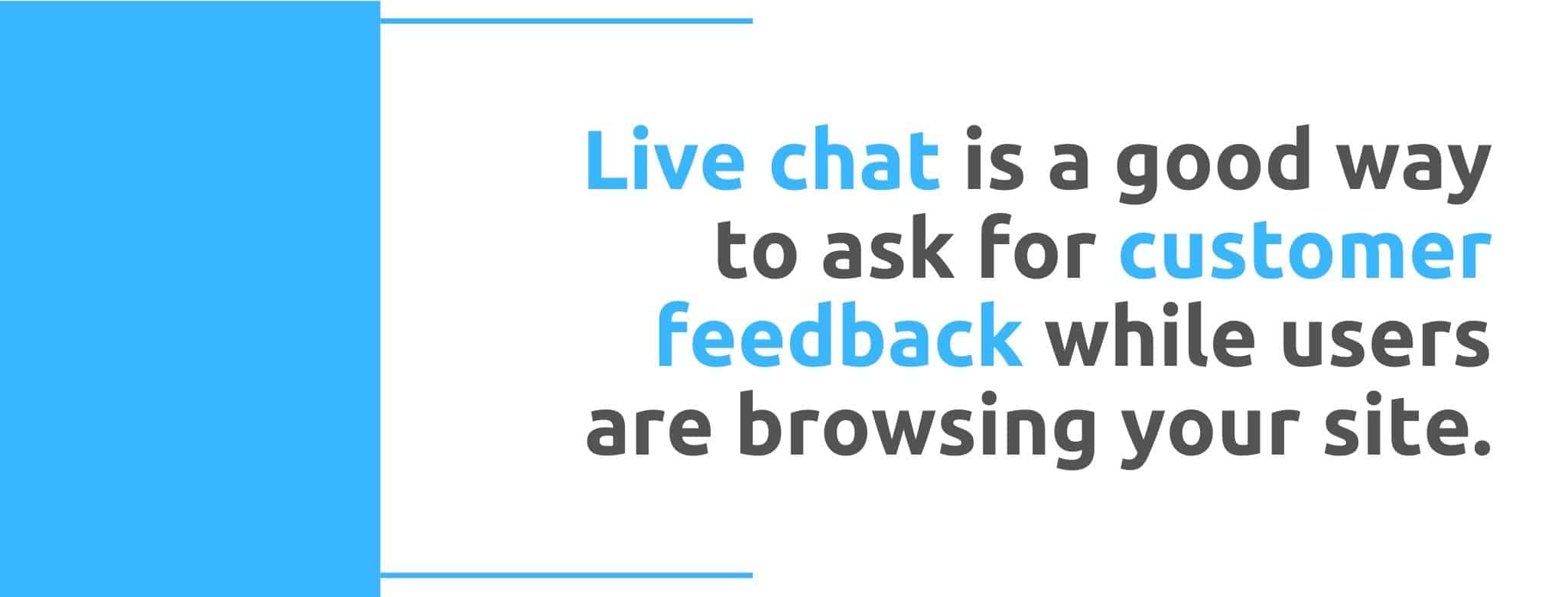22 Ways to Collect Customer Feedback — The Ultimate Guide

Customer feedback is crucial to business growth and profitability. Here are 22 different ways to collect it throughout the buyer journey.
Customer feedback is absolutely imperative for the growth of any type of sales-oriented business. This is true whether you work in brick and mortar retail, eCommerce or even as a real estate agent.
Why? Because customer feedback lets you know what your customers are looking for and what they like / don’t like about your offerings. You can use this information to make improvements that you may otherwise have never even considered. And those changes could have a lasting impact on your sales and success.
Think about it this way: you could have visitors abandoning your website left and right, but without feedback, you wouldn’t know that they’re leaving over a simple navigation issue. Or sales could be way down without you knowing why. But by simply collecting customer feedback, you might discover which products to add in order to boost purchases.
We could go on and on about the importance and effect of gathering and utilizing customer feedback. But the bottom line is, every successful sales company depends on it for growth and profitability. So how do you go about collecting it?
Any comprehensive feedback strategy has more to it than “How are we doing?” surveys (though surveys are a crucial component). Thankfully, we’re here to help. Keep reading to learn about 22 unique and effective ways to collect customer feedback throughout the buyer journey.

1. Surveys
The most common and familiar way to gather customer feedback is via surveys. In fact, surveys will be a component of many of the following 21 collection methods in some way or another. But first, let’s cover the basics.
The most frequently used survey types generally fall into two categories. There are online surveys, which are located right on a company’s website. And then there are surveys that businesses invite customers to complete.
Online Surveys
Online surveys are a quick set of questions that visitors to your website can answer. The responses to these surveys can help you improve factors such as website navigation, inventory and search functionality.
First, determine which page(s) on your website you want to gather feedback for. Then put together a short list of questions related to that page. Keep these surveys short, so as to avoid making users feel overwhelmed or inconvenienced. If you’re an eCommerce seller, you could place a small survey in the sidebar of your main products page. Good questions for this type of survey would be mostly “Yes / No” questions along the lines of:
- Was it easy to find the products you were looking for today? Yes / No
- Did you have any problems navigating our website? Yes / No
- On a scale of 1 to 10, how would you rate your shopping experience with our store? 1 2 3 4 5 6 7 8 9 10
- Do you have any suggestions on how we can improve the shopping experience or our product selection?
Invitation Surveys
Invitation surveys are a list of questions you invite customers to answer via email or some other form of communication. The timing of these surveys may vary, such as post-purchase questionnaires or customer service follow ups (more on that later). However, the general best practices will remain the same.
Your invitation survey questions can be included right in the body of the email. Or, conversely, you can provide a link to a separate survey landing page.
While an invitation survey can be a bit longer than an online survey, you still want to keep it short and to the point. We’ve all clicked on a survey with full intentions to fill it out, only to find that it “felt like work” once we opened it. You’ll want to avoid making your customers feel this way, as they’ll undoubtedly click away from your survey without finishing it.
In order to achieve this, keep your survey clean and quick, with short questions and easy ways to answer (such as “Yes / No” and 1 to 10 scales).
2. Follow-Up Emails
Follow-up emails are an excellent customer feedback collection tool. And the way they work is simple.
First, a customer contacts your company with a question or to receive some other form of customer service. Then, your customer service team addresses the customer’s issue. Finally, once this interaction is fully complete and the customer has been taken care of, you send out a follow-up email asking about their experience.
This is a great way to learn more about how your service team is performing. By asking a few pointed questions about a customer’s experience with your company’s support agents, you can determine what’s being handled properly and what, if anything, needs to be improved upon.
Please find a few examples of questions to include in a customer service follow-up email below:
- Did we fully answer your question(s) and / or address your issue(s)? Yes / No
- Did you feel like our customer service representative was attentive and empathetic to your needs? Yes / No
- Were you fully satisfied after this interaction? Yes / No
- Would you recommend us to your friends or family? Yes / No
- Do you have any comments, concerns or suggestions you’d like to share with us?

3. Post-Purchase Questionnaire
Similar to a follow-up email, a post-purchase questionnaire is a way to gather feedback after a customer has an experience with your company. Only this time, the survey is going out after they’ve made a purchase from you.
There are a few ways you can approach this method. Some sellers like to send out a survey immediately after a shopper completes the transaction in order to gauge things like how they enjoyed the website’s navigation, if they found everything they were looking for and why they selected the specific items they bought.
Another post-purchase tactic is to wait until after the items have been delivered. Then you can ask the above questions, while also adding queries about whether the customer is satisfied with the item(s) they purchased now that they’ve been received.
Choosing which of these methods to utilize, or opting to use both, depends on the type of information you want to collect. This is all based on the kinds of improvements you’re looking to make within your company, website and / or inventory.
4. Text Messages
When it comes to collecting customer feedback from today’s shoppers, text messages are a great way to go. After all, virtually everyone has a smartphone these days, and not all customers check their email on a regular basis.
A myriad of companies use this strategy to gather useful information from shoppers. First, in the same window where customers enter their email addresses when checking out or signing up for notifications, you’ll also include a spot for them to provide their cell phone number. You will also need to include a check-box through which they can opt in for SMS notifications / communications.
Once a customer has given you their cell phone number and agreed to receive text messages from your company, you can send them a series of texts with simple “Yes / No,” numerical or one-word response options. These questions will be situationally dependent.
For instance, if you’re texting customers after a purchase, the questions will revolve around their shopping experience. But if you’re surveying them after a customer service call, the queries will have to do with that interaction.

5. Direct Contact
One way to collect the most valuable customer feedback is by making direct contact. That’s because you can tailor your questions based specifically on the customer and how the conversation flows.
This method involves actually calling the customer and asking them questions about their experience with your company. Speaking with them live and in person gives you the unique opportunity to gauge their feelings about your store, website or company in a more comprehensive way.
While having an actual conversation with a customer, you give them the chance to really expand on their responses to your questions. They are more likely to give you more detail into their answers and why they feel the way they do than they would be if they had to write or type out their replies.
You can also base your follow-up questions on the customer’s previous answers in order to gain a full understanding of their feedback.
This approach also goes a long way towards building rapport with your shoppers. By taking the time to speak directly with them, you are showing that you genuinely care about the customer experience and about their opinions.
6. Customer Feedback Cards with Purchase
Here’s an easy way to gather customer feedback from shoppers after a purchase: send feedback cards with their order.
These small slips can be pre-self-addressed, postage-paid postcards, so that customers can simply fill them out and drop them in the mail. You can also include a link on the cards to an online version of the same survey. That way, customers can opt to simply fill them out online at their convenience.
By offering two choices for answering the short list of questions, you are increasing your odds of getting responses. Additionally, a feedback card in order packaging makes the customer feel like you care about their experience. Be sure to use language that also conveys your appreciation for their business, such as, “Thank you for shopping with us! We hope you love your items.”
7. Customer Feedback Button on Website
If you want to frequently encourage visitors to leave feedback, you should consider including a button on every page of your website. The text in this button might say something like, “Tell Us How We’re Doing,” “How Are We Doing?” or “Submit Feedback.”
When clicked, the button will link to a landing page that contains the survey you want users to complete. Again, keep the layout and questions simple. The last thing you want to do is bombard or inconvenience customers. Ask simple questions about website navigation, search ease and product selection satisfaction.

8. Website Popup
Much like the aforementioned online survey, a website popup collects customer feedback by asking a very short list of questions. Only, instead of being a static list of questions that lives at the bottom or sidebar of a webpage, this survey will popup at various times while shoppers browse your site.
This is a great way to place your survey right at the viewer’s eyeline, thus increasing the chances that customers will complete it. The popup approach also helps you to gather information about the shopping experience on your site while customers are in the middle of browsing. That kind of timing makes the answers you can receive with this method incredibly relevant and useful.
9. Customer Feedback Box
Another similar technique to the online survey is to include a customer feedback box on your website. Rather than asking a series of “Yes / No” or multiple-choice questions, you can provide a place for users to offer open-ended feedback.
This can be done with one, small section at the side or bottom of your webpages. The section should include a simple question or line of text, such as, “Let us know how we’re doing,” or “Have any questions, comments or suggestions? Provide your feedback here.” Then there will be a box users can click in to type out their comments, with a “Submit” button below it.
10. Public Roadmap
We utilize a customer feedback collection system here at Replyco that has been invaluable to our improvement and growth as both a company and a helpdesk solution. Our Public Roadmap invites customers to submit feature requests, comments, questions and any other feedback they would like. They can also view upcoming releases, bug fixes and improvements, while voting for their favorites.
The Public Roadmap has enabled us to keep our collective finger on the pulse of everything our customers want and need in order to best manage their multi-channel email communications. By fostering such open, transparent dialogue between our developers and our users, we have learned in-depth information about our customers’ preferences in a very short amount of time. Without the Roadmap, this same data may have taken us years to collect.
And at the same time, by openly sharing our plans for our tools and products, we are able to get immediate feedback into how customers feel about the upcoming changes. This enables on-the-fly adjustments and helps us avoid potential pitfalls.
Our customers have been overwhelmingly positive about the Public Roadmap. In fact, when we see customers talking about us on external forums, they often mention how impressed they are about this offering. We’ve seen countless comments about how Replyco listens to its customers and adds features / makes improvements quickly based on the Roadmap feedback.
If you’re a service-based company, it is highly advisable to include a similar page on your site that keeps customers apprised of what you’re planning and invites them to share their honest and immediate feedback. Whether you call it a roadmap, suggestion board or any other name, it could be the cornerstone of your customer-centric business.

11. Live Chat
Similar to a website popup, live chat is a great way to collect customer feedback while users are browsing your site. However, in this instance, you are adding the benefit of offering live customer service.
Here’s how live chat feedback works. When a user is browsing your website, you can set an automated chat beacon to popup and ask about their shopping experience with your store. The chat window can proceed into a series of short, easy-answer-questions that will gather information about how customers feel about your website, inventory and the like.
Within this chat window, you can also ask if the customer has any questions. If they do, a live agent will then be signalled to get on the chat and assist them.
Not only does this method allow you to receive on-the-spot user feedback, it also gives you the opportunity to showcase how devoted to customer service your company is. And by answering customer questions via live chat, you may be able to close a sale when a user might otherwise have left your site.
12. Social Media
Social media is an excellent platform through which to collect customer feedback, and there are a myriad of ways to do so. Just a few examples of ways to gather information include:
- Creating posts with links to surveys.
- Posting short survey questions directly inside your social media posts.
- Publish questions or polls inside your Instagram Stories.
- Sending direct messages to users that follow you.
You can also monitor social media by searching for your company name to see when you’re being discussed. This gives you the chance to respond to both positive and negative comments in a way that boosts your company’s reputation and showcases you as a business that values customer opinion and experience.
Likewise, you can post blogs with links to surveys and browse forums related to your industry in order to get in on the conversations that are relevant to your brand.
SurveyMonkey even suggests implementing social media contests to encourage customers to provide feedback. In order to do this, you’ll create a contest in which the winner gets a prize. All users must do to enter their name in the contest is to complete your survey.

13. In-App Customer Feedback Surveys
Want to know how customers feel about your app? Use in-app surveys to ask questions about usability, search ease, navigation and the like.
This type of customer feedback can help you improve your website’s app and increase the odds of having more users sign up for it. That’s because, the more customer-feedback-based tweaks you make, the more likely you are to receive 5-star reviews. And the more 5-star reviews you have on your app, the more people who will register to use it.
14. User Testing
User testing is a great way to gain valuable knowledge about how well your website performs amongst customers. Rather than having customers complete your survey, this is a method by which you utilize tools through an external site to gather in-depth feedback analytics.
Websites such as Usability Hub and UserTesting.com enable you to view real people using your site and then get feedback on their experience. While this process used to cost thousands of dollars and require outsourcing to an entire research firm, these types of user testing websites now enable any business owner to gain real-world usage insights into their website’s functionality and performance.
15. Incentives for Customer Feedback
If you want to encourage more people to complete your surveys or leave customer feedback, consider offering an incentive. Any shopper is going to be more likely to fill out a questionnaire if they’re getting something good in return.
Get creative. You could offer a percentage discount off the customer’s next order, free shipping, a special gift or exclusive early access to a new item. The possibilities are endless. You can even use a lead magnet to inspire more people to leave feedback. For instance, if you’re a laptop seller, consider offering a free guide to buying the right laptop for your needs in exchange for survey completion.
Just make sure you aren’t using this incentive to request positive reviews. You need to make it very clear that you are seeking honest feedback, and that the incentive is available to all responders — whether their feedback is positive or negative. This distinction is especially important if you’re an Amazon seller, as Amazon expressly prohibits the solicitation of positive reviews.

16. Analytics
Website analytics aren’t just for monitoring and improving your SEO. You can also use them to gather feedback on the customer experience. For example, your analytics will let you know if users are leaving your site after clicking on a certain page. Then you can assess and hopefully fix the problem that’s causing so many bounces.
On the flipside, you can also use analytics to determine which pages or sections of your website are performing well. This gives you a great opportunity to learn what about those pages customers are responding to. Then you can duplicate the success throughout your site.
17. Customer Preferences / Interests Collection
A customer feedback collection tool many sales pros use is to gather user preferences / interests upfront. This involves a quick questionnaire popping up as soon as a visitor opens a website. The questions will revolve around what the customer is looking for or interested in.
The customer preferences method is often seen on real estate websites. The questions asked typically include information about home seekers are looking for. They may include whether a shopper wants to buy or rent, how many bedrooms / bathrooms they’re seeking and their budget.
No matter what type of business you run, allowing users to self-select their interests can help you better serve customers. This approach can also lead to more closed sales. Additionally, the information collected gives you a lot of insight into the demographics that are visiting your website.
18. Recorded Sales Calls
Want to learn more about how prospects are responding to your sales team? Try recording sales calls. This is a great opportunity to both gather unique customer feedback and also to assess how your sales team is performing.
By recording these calls and listening back to them, you have the time to really dig into the details. This allows you to tweak every aspect of your sales approach. And after conducting this research, you can go back to the “follow-up” survey method. Because now it’s time to check in with the customer and learn even more about their experience and opinion.

19. Website Session Replays
An often overlooked, yet highly useful, customer feedback technique is to record and rewatch website session replays. This approach involves recording user activity on your website, and then watching it back to learn more about visitor habits.
Much like analytics, website session replays allow you to gain in-depth information about webpage performance. You can learn what pages are holding user interest and which ones are experiencing excessive click-aways.
You can also use session replays to see when customers might be having trouble navigating certain pages. These insights will enable you to make effective website changes and updates that can dramatically improve usability and customer satisfaction.
20. NPS Score
A Net Promoter Score or NPS is a great indicator of how customers feel about your company, website and offerings. This platform measures customer experience and predicts business growth. It also showcases how likely customers are to recommend you to a friend, family member or colleague.
When invited to complete an NPS survey, respondents are asked to share how likely they are to recommend a company to an acquaintance. A person who answers with a number from 0 to 6 is considered to be a “detractor.” While scorers from 7 to 8 are labeled as “passives.” Finally, those who respond with a 9 or 10 are “promoters” of your company.
While you obviously want to get lots of “promoters,” the information you can collect from your “detractors” and “passives” can also help you to make necessary changes that foster better performance, customer experience and company growth.
21. Gather Customer Feedback at Live Events
If your industry involves going to live events to promote your products or company, use those gatherings to collect customer feedback.
Simply print out various types of surveys to have visitors to your kiosk or booth fill out, based on the level of customer they are. For instance, if someone is new to your company and only learning about you for the first time at the event, have them complete a “first impressions” survey. Whereas, if a booth visitor proclaims themselves to be a long-time customer, have them fill out a full customer experience survey.
By receiving live input from individuals at all levels of the prospect / customer journey, you can get a clear picture of how the public views your company and products. This kind of information can go a long way toward helping you hone your image and improve your wares.

22. Long-Term Surveys
While many of the aforementioned customer feedback tactics involve targeting shoppers while they browse your website or immediately after a purchase / interaction, long-term surveys have an important place in your company structure.
That’s because this approach works by giving a customer time to really experience your products and services before providing their opinion on them. When conducting long-term surveys, you need to wait until a buyer has had plenty of time to receive and use any item they’ve purchased from you.
Once a fair amount of time has passed, you can send this customer a survey. The survey should include in-depth questions regarding the usability / quality of your product(s) and the customer’s experience with your company.
The long-term method fosters ongoing relationships with customers. It also centers around collecting feedback from experienced users who can provide uniquely useful advice on potential changes or improvements.
Final Thoughts: Great Service Encourages Positive Customer Feedback
When going to such lengths to collect customer feedback, you also need to do everything you can to make sure it’s positive. The first and most important step in this endeavor is always going to be customer service.
With great customer service, you can foster incredible relationships with customers. You can also make sure they are always fully satisfied following any transaction or interaction with your company. Every single member of your team should be of the same mind: completely dedicated to the customer experience.
And one of the most crucial ways to provide stellar customer service is through excellent message management. This is especially true if you sell via multiple channels, such as Amazon, eBay and Shopify.
That’s why Replyco is here to help. We allow you to view and reply to all customer messages from every selling channel in one, easy-to-use inbox.
Are you ready to achieve lightning-fast response rates, boost ROI and start receiving amazing customer feedback? Then start your FREE trial today!
Want to learn more first? No problem. Feel free to take a tour of features any time.





